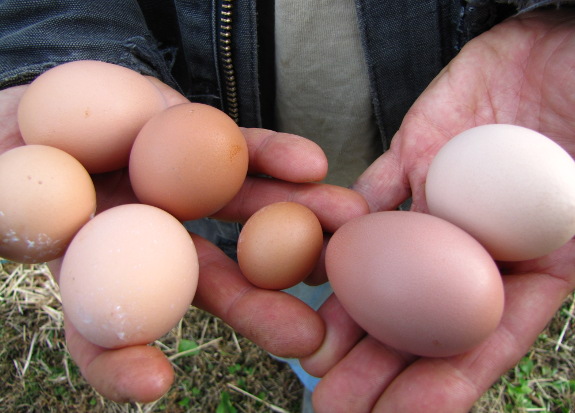
Egg season!

We've now got seven hens
laying! That tiny egg in the middle is a pullet
egg, the smallest one I've ever
seen. Sometimes, a hen will produce a tiny, yolkless egg when
she's first starting to lay, so I think this picture (taken November 3)
marks the date when our last Cuckoo Marans hen came into production.
The eggs are smaller,
prettier, and less numerous than we were getting from our Golden Comets, but I hope that our
heirloom Black Australorps and Cuckoo Marans will make up for their
lower yields by eating less storebought feed and raising their own
young. Right now, we're getting around 0.475 pounds of eggs per
day (4 medium eggs) and are feeding the flock roughly 1 pound of laying
pellets. That's a feed
conversion rate of
2.1:1 and a feed cost of about $1 per dozen eggs. Not too shabby,
even if you factor in having to feed the flock for six months before
they start to lay.
Keep up the good work,
girls! We like having extra eggs to sink into lemon
meringue pies.
Want more in-depth information? Browse through our books.
Or explore more posts by date or by subject.
About us: Anna Hess and Mark Hamilton spent over a decade living self-sufficiently in the mountains of Virginia before moving north to start over from scratch in the foothills of Ohio. They've experimented with permaculture, no-till gardening, trailersteading, home-based microbusinesses and much more, writing about their adventures in both blogs and books.
Want to be notified when new comments are posted on this page? Click on the RSS button after you add a comment to subscribe to the comment feed, or simply check the box beside "email replies to me" while writing your comment.

Fritz --- It's probably just the angle, although the one older hen we have (a cochin) does lay eggs a bit bigger than the pullet eggs.
Ellen --- It was indeed yolkless, which I guess explains the tiny size. I'm pretty sure that's the first yolkless pullet egg I've ever seen, although I have read about them. Mark mentioned a shell-less egg the day before we got this tiny pullet egg, so it's possible one of the hens just took a while to work up to real eggs.